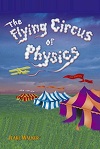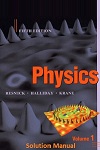The Flying Circus of Physics (2E) by Jearl Walker
MathSchoolinternational contain thousands of
Mathematics Free Books and
Physics Free Books. Which cover almost all topics for students of Mathematics, Physics and Engineering. We have also collected other
Best Free Math Websites for teachers and students.
for teachers and students.
Here is extisive list of
Basic Physics Free PDF Books . We hope person who’s interested in Physics like these books.
Share this page:-

Congratulations, the link is avaliable for free download.
About this book :-
The Flying Circus of Physics (2E) written by
Jearl Walker .
Witness astounding feats of physicsHurry! Hurry! Come one, come all. Meet a man who can pull two railroad passenger cars with his teeth and a real-life human cannon ball. Come face to face with a dead rattlesnake that still bites. And unlock the secrets to the magician's bodiless head.Welcome to Jearl Walker's Flying Circus of Physics, 2nd Edition, where death-defying stunts, high-flying acrobatics, strange curiosities, and mind-bending illusions are all part of everyday life. You don't need a ticket; you only need to look to the world around you to uncover these fascinating feats of physics.Completely updated and expanded, this Second Edition of Jearl Walker's best-selling book features more than 700 thoroughly intriguing questions about relevant, fun, and completely real physical phenomena. Detailed explanations and references to outside sources guide your way through the problems.You'll discover answers to such questions as:* Can you start a fire with ice?* Why does the sky turn green just before a tornado?* Why do wintergreen LifeSavers glow in the dark when you bite them?* If you are falling in an elevator, should you try to jump up at the last second or lay flat against the floor?* How do electric eels produce their electric field?* Why is wet sand darker than dry sand?* What causes an oasis mirage?* Why do stars twinkle?* Could you drive a car on a ceiling?
The Flying Circus of Physics began one dark and dreary night in 1968 while I was a graduate student at the University of Maryland. Well, actually, to most graduate students nearly all nights are dark and dreary, but I mean that particular night was really dark and dreary. I was a full-time teaching assistant, and earlier in the day I had given a quiz to Sharon, one of my students. She did badly and at the end turned to me with the challenge, "What has anything of this to do with my life?"
I jumped to respond, "Sharon, this is physics! This has everything to do with your life!"
As she turned more to face me, with eyes and voice both tightened, she said in measured pace, "Give me some examples."
I thought and thought but could not come up with a single one. I had spent at least six years studying physics and I could not come up with even a single example.
That night I realized that the trouble with Sharon was actually the trouble with me: This thing called physics was something people did in a physics building, not something that was connected with the real world of Sharon (or me). So, I decided to collect some real-world examples and, to catch her attention, I called the collection The Flying Circus of Physics. Gradually I added to the collection. Soon other people wanted copies of the Flying Circus material, first students in Sharon's class, then my fellow graduate students, and then some of the faculty members. After the material was printed as a "technical report" by the Physics Department at Maryland, I landed a book contract with John Wiley & Sons.
The book was published in 1975, a few years after I became a physics professor at Cleveland State University; it was revised in 1977. Since then it has been translated into 11 languages for publication around the world. This is the second edition of the book, which is completely rewritten and redesigned.
When I began writing Flying Circus material, I searched through only a few dozen research journals, page by page, and discovered few relevant papers. Indeed, my metaphor for the project was that I was digging for gold in an almost barren mountainside-the gold nuggets were few and hard to find.
The world has changed: Now, many hundreds of research papers with potential Flying Circus material are published every year and, in terms of my metaphor, I find huge gold veins. And now I don't dig through just a few dozen journals; I look through about 400 journals directly and use search engines to sort through hundreds more. On many days my fmgers just fly over my computer keyboard. I wish Sharon could look over my shoulder at all the really curious things I find. With this book you get that chance: Come look over my shoulder and you'll see that physics "has everything to do with your life. (Jearl Walker)
Book Detail :-
Title: The Flying Circus of Physics
Edition: 2nd
Author(s): Jearl Walker
Publisher: John Wiley & Sons
Series:
Year: 2006
Pages: 348
Type: PDF
Language: English
ISBN: 0471762733,9780471762737
Country: US
About Author :-
The author Jearl Walker (born 1945 in Pensacola, Florida) professor of physics at Cleveland State University, received his BS in physics from MIT in 1967 and his PhD in physics from University of Maryland in 1973.
His book The Flying Circus of Physics was first published 41 years ago and was translated into at least 10 languages. The second edition was published in 2006 and is still being translated into other languages. For 16 years he toured his Flying Circus talk throughout the U.S. and Canada, introducing such physics stunts as the bed-of-nails demonstration and the walking-on-hot-coals demonstration to countless physics teachers, who then proceeded to hurt themselves when they repeated the stunts in their own classrooms. These talks led to his PBS television series Kinetic Karnival that was rerun nationally for years and which landed him a local Emmy, now proudly displayed in his first-floor bathroom. Since then he was on the Canadian radio Quirks and Quarks weekly for 11 years and, later, on the Discovery Channel Canada show Daily Planet numerous times.
During his 13 years with Scientific American magazine, he wrote 152 articles for The Amateur Scientist section, which were translated into at least 9 languages world wide and had over 2 million readers each month. His topics ranged from the physics of judo to the physics of béarnaise sauce and lemon meringue pies. In 1990, he took over the textbook Fundamentals of Physics from David Halliday and Robert Resnick, the textbook he used in his first year at MIT. Since then he has published eight editions of the book, with 18 translations and selling over one million copies in North America and perhaps three or four million copies world wide (it is the number one book world wide in its market). He has lost count of the number of times he has been on television and radio and interviewed for newspapers and magazines. However, he clearly remembers the 20 minutes he spent performing on The Tonight Show with Johnny Carson, where he stuck his fingers into molten lead without losing any of them, to the great relief of h is mother who was at home watching the show.
About Author :-
The author David Halliday (1916–2010) was an American physicist known for his physics textbooks, Physics and Fundamentals of Physics, which he wrote with Robert Resnick. Both textbooks have been in continuous use since 1960 and are available in more than 47 languages.
Halliday attended the University of Pittsburgh both as an undergraduate student and a graduate student, receiving his Ph.D. in physics in 1941. During World War II, he worked at the MIT Radiation Lab developing radar techniques. In 1946 he returned to Pittsburgh as an assistant professor and spent the rest of his career there. In 1950, he wrote Introductory Nuclear Physics, which became a classic text and was translated into four languages. In 1951 Halliday became the Department Chair, a position he held until 1962.
His Physics has been used widely and is considered by many to have revolutionized physics education. Now in its tenth edition in a two-volume set revised by Jearl Walker, and under the title Fundamentals of Physics, it is still highly regarded. It is noted for its clear standardized diagrams, very thorough but highly readable pedagogy, outlook into modern physics, and challenging, thought provoking problems. In 2002 the American Physical Society named the work the most outstanding introductory physics text of the 20th century.
The author Robert Resnick (1923–2014) was a physics educator and author of physics textbooks.
He was born in Baltimore, Maryland on January 11, 1923 and graduated from the Baltimore City College high school in 1939. He received his B.A. in 1943 and his Ph.D. in 1949, both in physics from Johns Hopkins University. From 1949 to 1956, he was a member of the faculty at the University of Pittsburgh, where he first met David Halliday, with whom he wrote his most widely read textbook. He later became a professor at Rensselaer Polytechnic Institute and was head of the interdisciplinary science curriculum for fifteen years. During his years at RPI, he authored or co-authored seven textbooks on relativity, quantum physics, and general physics, which have been translated into more than 47 languages. It is estimated that over 10 million students have studied from his books. In 1960, Physics, the first-year textbook he wrote with Prof. Halliday, was published. The book has been used widely and is considered to have revolutionized physics education. Now in its tenth edition in a five-volume set revised by Jearl Walker, and under the title Fundamentals of Physics, it is still highly regarded. It is noted for its clear standardized diagrams, very thorough but highly readable pedagogy, outlook into modern physics, and challenging, thought provoking problems. In 2002 the American Physical Society named the work the most outstanding introductory physics text of the 20th century.
He received the Oersted Medal (1974), the highest award given by the American Association of Physics Teachers, and was president of that society from 1986 to 1990. As well as being a Fulbright Scholar, he was also an honorary research fellow and visiting professor at Harvard University (1964–65). Other awards include that of being an Honorary Visiting Professor to the People's Republic of China (in 1981 and 1985), the Exxon Foundation Award for Outstanding Teaching (1954), the RPI Distinguished Faculty Award (1971), Outstanding Educator of the Year (1972), a fellow of the American Physical Society and of the American Association for the Advancement of Science, and a member of the Phi Beta Kappa and Sigma Xi honorary societies.
All Famous Books of this Author :-
Here is list all books, text books, editions, versions or solution manuals avaliable of this author, We recomended you to download all.
• Download PDF Physics 1 (5E) by Robert Resnick, David Halliday, Kenneth Krane 
• Download PDF Physics 1 (Soluton Manual) by Robert Resnick, David Halliday, Kenneth Krane 
• Download PDF Physics 2 (4E) by Robert Resnick, David Halliday, Kenneth Krane  '
'
• Download PDF Fundamentals of Physics (8E) Solution by Jearl Walker, Robert Resnick, David Halliday 
• Download PDF Fundamentals of Physics Extended (8E) by Jearl Walker, Robert Resnick, David Halliday 
• Download PDF Fundamentals of Physics (9E) by David Halliday, Robert Resnick, Jearl Walker 
• Download PDF Fundamentals of Physics (9E Solution Manual) by David Halliday, Robert Resnick, Jearl Walker 
• Download PDF Fundamentals of Physics Extended (10E) by David Halliday, Robert Resnick, Jearl Walker 
• Download PDF Fundamentals of Physics Extended (10E Solution Manual) by David Halliday, Robert Resnick, Jearl Walker 
• Download PDF Principles of Physics (10E) by David Halliday, Robert Resnick, Jearl Walker  '
'
• Download PDF The Flying Circus of Physics (2E) by Jearl Walker 
• Download PDF The Flying Circus of Physics (2E): with Answers by Jearl Walker 
Join our new updates, alerts:-
For new updates and alerts join our WhatsApp Group and Telegram Group (you can also ask any [pdf] book/notes/solutions manual).
 Join WhatsApp Group
Join WhatsApp Group
 Join Telegram Group
Join Telegram Group
Book Contents :-
The Flying Circus of Physics (2E) written by
Jearl Walker
cover the following topics.
1. Slipping Between Falling Drops (MOTION)
2. Racing on the Ceiling, Swimming Through Syrup (FLUIDS)
3. Hiding under the Covers. listening for the Monsters (SOUND)
4. Striking at the Heat in the Night (THERMAL PROCESSES)
5. Ducking First a Roar and Then a Flash (ELECTRICITY AND MAGNETISM
6. Splashing Colors Everywhere, Like a Rainbow (OPTICS)
7. Armadillos Dancing Against a Swollen Moon (VISION)
Note:-
We are not the owner of this book/notes. We provide it which is already avialable on the internet. For any further querries please contact us. We never SUPPORT PIRACY. This copy was provided for students who are financially troubled but want studeing to learn. If You Think This Materials Is Useful, Please get it legally from the PUBLISHERS. Thank you.





